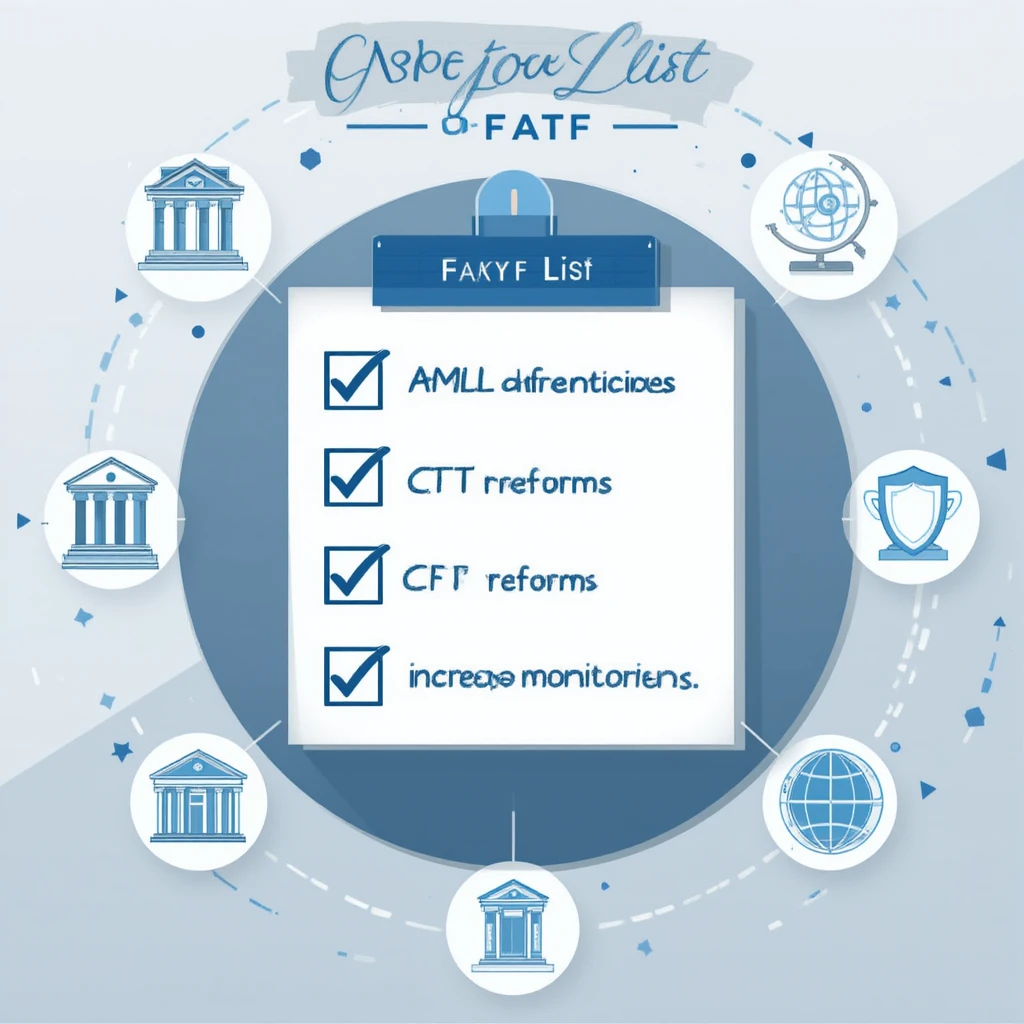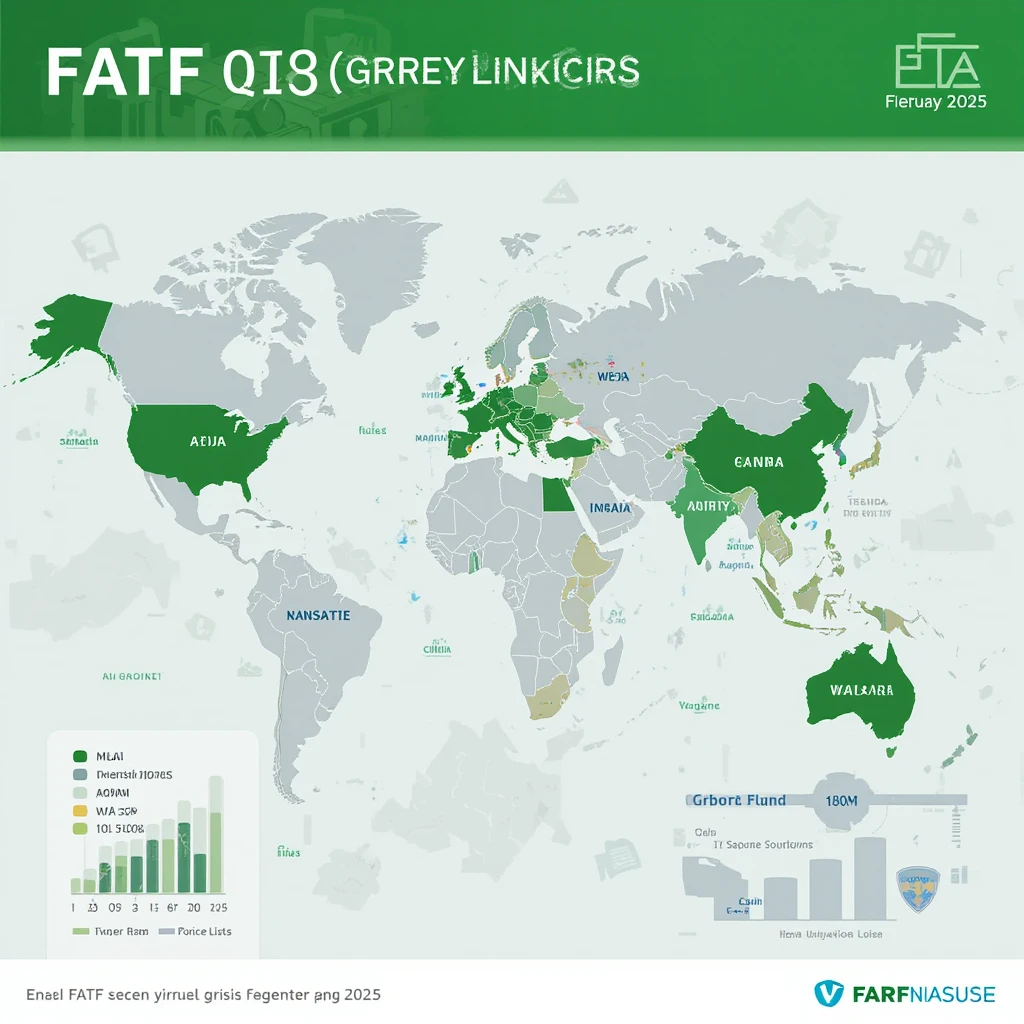The FATF Grey List, formally known as “Jurisdictions under Increased Monitoring,” is a pivotal tool in the global fight against financial crimes, including money laundering, terrorist financing, and proliferation financing. Established by the Financial Action Task Force (FATF), this list identifies countries with strategic deficiencies in their anti-money laundering (AML), counter-terrorism financing (CFT), and counter-proliferation financing (CPF) frameworks. Unlike the FATF Blacklist, which targets non-cooperative high-risk jurisdictions, the FATF Grey List serves as both a warning and an opportunity for countries to address their shortcomings through structured reforms. This article provides an in-depth, exploration of the FATF Grey List, including the countries currently listed, reasons for their inclusion, the purpose of the list, the Terms of Reference (TOR) of the FATF, and its broader implications. With a focus on clarity and accessibility, this guide is designed to rank well on Google while maintaining originality and a keyword density of less than 1.5% for the term FATF Grey List.

Table of Contents
What is the FATF Grey List?
The FATF Grey List is a designation by the Financial Action Task Force for countries that have deficiencies in their AML/CFT/CPF regimes but are actively cooperating with the FATF to address these issues. These jurisdictions are placed under “increased monitoring,” meaning they must implement an action plan within a specified timeframe to resolve identified gaps. The FATF Grey List is distinct from the Blacklist, officially called “High-Risk Jurisdictions subject to a Call for Action,” which includes countries like Iran, North Korea, and Myanmar that face severe sanctions due to non-compliance.
The FATF Grey List serves as a global signal to financial institutions, governments, and businesses to exercise enhanced due diligence when dealing with listed countries. This designation aims to protect the international financial system by encouraging jurisdictions to align with the FATF’s 40 Recommendations, a set of global standards for combating financial crimes. The list is updated during FATF plenary meetings, typically held three times a year, reflecting changes in countries’ compliance status.

Why the FATF Grey List Matters
The FATF Grey List plays a critical role in maintaining the integrity of the global financial system. By identifying jurisdictions with weaknesses, it helps prevent the exploitation of financial systems for illicit activities such as drug trafficking, human trafficking, and terrorism. Moreover, it fosters international cooperation, as listed countries work with the FATF and its regional bodies to implement reforms. The FATF Grey List also promotes transparency and accountability, ensuring that countries prioritize robust financial regulations.
Countries on the FATF Grey List (February 2025)
As of the FATF Plenary meeting on February 21, 2025, the FATF Grey List includes the following 25 jurisdictions:
- Algeria
- Angola
- Bulgaria
- Burkina Faso
- Cameroon
- Côte d’Ivoire
- Croatia
- Democratic Republic of the Congo
- Haiti
- Kenya
- Lao PDR
- Lebanon
- Mali
- Monaco
- Mozambique
- Namibia
- Nepal
- Nigeria
- South Africa
- South Sudan
- Syria
- Tanzania
- Venezuela
- Vietnam
- Yemen
Recent Updates to the FATF Grey List
The FATF Grey List is dynamic, with countries added or removed based on their progress in addressing deficiencies. In February 2025, Nepal and Lao PDR were added due to persistent gaps in financial oversight and regulatory enforcement. Conversely, the Philippines was removed after nearly four years of reforms, including amendments to its Anti-Money Laundering Act and successful on-site evaluations. Other recent removals include Senegal (October 2024), Barbados, Gibraltar, Uganda, and the United Arab Emirates (February 2024), and Jamaica and Türkiye (June 2024). These changes highlight the FATF Grey List’s role as a tool for encouraging measurable progress.

How Countries Are Selected for the FATF Grey List
The FATF identifies jurisdictions for the FATF Grey List through mutual evaluations and ongoing monitoring. Mutual evaluations assess a country’s compliance with the FATF’s 40 Recommendations, focusing on technical compliance (legal frameworks) and effectiveness (practical implementation). Countries with strategic deficiencies are prioritized based on criteria revised in October 2024, which emphasize:
- FATF member states.
- High-income countries with significant financial sectors (per World Bank classification).
- Jurisdictions with financial sector assets exceeding USD 10 billion.
Least developed countries, as defined by the United Nations, are granted a two-year observation period unless they pose significant risks, reflecting the FATF’s commitment to fairness and capacity considerations.
Why Are Countries Placed on the FATF Grey List?
Countries are added to the FATF Grey List when they exhibit strategic deficiencies in their AML/CFT/CPF frameworks. These deficiencies vary but typically include:
- Weak Regulatory Oversight
Inadequate supervision of high-risk sectors, such as banks, casinos, real estate, or non-profit organizations, leaves systems vulnerable to exploitation. For instance, Nepal was listed in February 2025 due to insufficient monitoring of high-risk sectors. - Inadequate Legal Frameworks
Countries may lack robust laws to criminalize money laundering, terrorist financing, or proliferation financing. Alternatively, existing laws may not be enforced effectively, allowing financial crimes to persist. - Poor Investigation and Prosecution
Limited capacity to investigate and prosecute financial crimes, especially transnational cases, is a common issue. Algeria, added in October 2024, faced challenges in prosecuting complex financial crimes. - Lack of Transparency
Failure to maintain accurate beneficial ownership information for companies and trusts enables criminals to conceal their identities. This was a key deficiency for Monaco, listed in October 2024. - Non-Compliance with FATF Standards
Incomplete adherence to the FATF’s 40 Recommendations, such as ineffective customer due diligence or weak suspicious transaction reporting, often leads to Grey List inclusion. - Emerging Risks
Vulnerabilities to new threats, such as virtual assets, cross-border payment systems, or proliferation financing linked to weapons of mass destruction, can trigger listing. Lao PDR’s inclusion in February 2025 was partly due to gaps in virtual asset regulation.

Case Studies: Why Specific Countries Are on the FATF Grey List
- South Africa: Listed due to weaknesses in beneficial ownership transparency and ineffective prosecution of money laundering cases, despite being a major financial hub in Africa.
- Nigeria: Included for inadequate supervision of non-financial sectors, such as real estate, and limited effectiveness in combating terrorist financing.
- Lebanon: Added due to challenges in financial sector oversight amid economic and political instability, coupled with weak enforcement of AML/CFT laws.
- Nepal: Newly listed in 2025 for slow implementation of recommendations from its 2022 mutual evaluation, particularly in high-risk sector monitoring.
These examples illustrate the diverse reasons for FATF Grey List inclusion, ranging from systemic governance issues to sector-specific vulnerabilities.
The Purpose of the FATF Grey List
The FATF Grey List serves multiple purposes, balancing enforcement with cooperation to strengthen global financial integrity. Its key objectives include:
- Encouraging Compliance
By publicly identifying deficiencies, the FATF Grey List incentivizes countries to implement reforms. The threat of economic consequences, such as reduced foreign investment, motivates governments to act swiftly. For example, Pakistan’s removal in October 2022 followed significant legislative and enforcement improvements. - Protecting the Global Financial System
The list alerts financial institutions to apply enhanced due diligence when dealing with Grey List countries, reducing risks of money laundering and terrorist financing. This ensures that illicit funds do not flow unchecked through global markets. - Facilitating Technical Assistance
Grey-listed countries receive support from the FATF and FATF-Style Regional Bodies (FSRBs), such as the Asia/Pacific Group on Money Laundering (APG). This assistance includes capacity building, policy guidance, and on-site evaluations to monitor progress. - Promoting Financial Inclusion
The FATF emphasizes a risk-based approach to avoid de-risking, where banks sever ties with entire jurisdictions or customer groups. The FATF Grey List encourages targeted measures to ensure legitimate activities, such as humanitarian aid and remittances, are not disrupted. - Signaling Progress
Unlike the Blacklist, the FATF Grey List acknowledges a country’s commitment to reform. Successful implementation of action plans leads to delisting, as seen with the UAE in February 2024, signaling improved financial integrity to the global community.

Measuring the Effectiveness of the FATF Grey List
The FATF Grey List has driven significant reforms worldwide. For instance, Mauritius and Botswana, delisted in October 2021, strengthened their AML/CFT frameworks, enhancing their attractiveness to investors. Similarly, the Philippines’ removal in February 2025 followed robust legislative changes, demonstrating the list’s role in fostering accountability. However, the effectiveness depends on countries’ political will, resources, and capacity to implement reforms within agreed timelines.
Economic and Political Implications of the FATF Grey List
Inclusion on the FATF Grey List carries significant consequences, impacting economies, politics, and international relations.
Economic Impacts
- Higher Transaction Costs
Financial institutions in Grey List countries face increased compliance costs due to enhanced due diligence requirements. This can raise the cost of cross-border transactions, affecting businesses and consumers. - Reduced Foreign Investment
The FATF Grey List signals higher risk, deterring foreign direct investment (FDI). For example, Pakistan faced challenges attracting FDI during its Grey List tenure from 2018 to 2022. - Restricted Access to Financing
International lenders, such as the IMF and World Bank (both FATF observers), may impose stricter conditions on Grey List countries. Pakistan struggled to secure a USD 6 billion IMF loan in 2019 due to its listing. - Trade Disruptions
Grey List status can complicate trade relationships, as partners may impose additional scrutiny on financial transactions, delaying processes and increasing costs.
Political Implications
- Domestic Pressure
Businesses, civil society, and political actors often pressure governments to expedite reforms to avoid prolonged economic strain. This was evident in Türkiye, which implemented sweeping changes to exit the FATF Grey List in June 2024. - International Reputation
Grey List inclusion damages a country’s global standing, portraying it as a higher-risk jurisdiction. This can affect diplomatic relations and participation in international forums. - Policy Reforms
The FATF Grey List often catalyzes legislative and institutional changes, strengthening governance. For instance, the UAE’s delisting in February 2024 followed enhanced AML/CFT measures, boosting its reputation as a financial hub.
Opportunities for Improvement
Despite its challenges, the FATF Grey List offers opportunities for long-term gains. Countries that address deficiencies often emerge with stronger, more transparent financial systems, attracting investment and fostering economic stability. The UAE and Türkiye are prime examples, having leveraged their Grey List experience to enhance financial regulations.
Terms of Reference (TOR) of the FATF
The FATF’s Terms of Reference (TOR) outline its mission, objectives, and operational framework, guiding its efforts to combat financial crimes. The TOR, periodically updated, provides a roadmap for the FATF’s global activities, including the management of the FATF Grey List. Key components include:
Objectives
- Set Global Standards
The FATF develops the 40 Recommendations, a comprehensive framework for preventing money laundering, terrorist financing, and proliferation financing. - Promote Implementation
The FATF encourages countries to adopt and enforce legal, regulatory, and operational measures to align with its standards. - Foster Cooperation
The FATF facilitates international collaboration to detect, disrupt, and prosecute financial crimes, ensuring a coordinated global response.
Functions
- Standard-Setting
The FATF updates its Recommendations, interpretive notes, and guidance to address emerging risks, such as virtual assets and cross-border payment systems. - Monitoring and Assessment
Through mutual evaluations, the FATF assesses countries’ compliance, identifying deficiencies and recommending corrective actions. These evaluations inform FATF Grey List decisions. - Listing Jurisdictions
The FATF maintains the Grey List and Blacklist to highlight jurisdictions with deficiencies and encourage reforms. The FATF Grey List is a key tool in this process. - Policy Development
The FATF addresses new threats, such as online child sexual exploitation and sanctions evasion, through reports and guidance. - Coordination with FSRBs
The FATF collaborates with nine FATF-Style Regional Bodies, such as the Middle East and North Africa FATF (MENAFATF), to ensure global implementation of its standards.
Membership and Structure
- Membership: The FATF comprises 40 members, including 37 jurisdictions and two regional organizations (the European Commission and the Gulf Cooperation Council). Over 200 jurisdictions are part of the FATF network through FSRBs.
- Secretariat: Hosted at the OECD headquarters in Paris, the Secretariat supports FATF operations, though the FATF is a separate entity.
- Governance: The FATF is led by a President (currently Elisa de Anda Madrazo of Mexico, as of 2025), with a Plenary and working groups overseeing its activities.
Key Priorities
- Financial Inclusion
The FATF promotes risk-based approaches to avoid de-risking, ensuring access to financial services for vulnerable populations. - Emerging Risks
The FATF addresses new challenges, such as virtual assets and proliferation financing, to stay ahead of evolving threats. - Support for Least Developed Countries
The FATF provides tailored assistance and extended timelines for low-capacity jurisdictions, as reflected in its revised Grey List criteria. - Diversity and Inclusivity
The FATF emphasizes women’s leadership and broader jurisdictional participation to enhance its global impact.
The TOR ensures that the FATF remains adaptable, responsive, and inclusive, with the FATF Grey List serving as a cornerstone of its monitoring and enforcement efforts.
Challenges and Criticisms of the FATF Grey List
While the FATF Grey List is a powerful tool, it faces several challenges and criticisms:
- Capacity Constraints
Low-capacity countries, particularly least developed nations, struggle to implement reforms within agreed timeframes. This can lead to prolonged listing or escalation to the Blacklist, as seen with some jurisdictions. - Economic Disparity
Critics argue that the FATF Grey List disproportionately affects developing economies, exacerbating financial exclusion and economic challenges. The FATF’s revised criteria (October 2024) aim to address this by prioritizing high-risk jurisdictions. - Political Sensitivities
Some countries perceive Grey List inclusion as politically motivated. The FATF counters this by emphasizing its technical, evidence-based approach, but tensions persist. - De-Risking
Overzealous application of enhanced due diligence can lead to de-risking, where banks sever ties with entire jurisdictions, disrupting legitimate financial flows. The FATF encourages risk-based measures to mitigate this. - Resource Intensity
Implementing FATF recommendations requires significant resources, including trained personnel, technology, and legislative reforms. This can strain smaller economies, delaying progress.
To address these challenges, the FATF has introduced measures such as humanitarian exemptions under UN Security Council Resolutions (e.g., UNSCR 2664) and extended timelines for least developed countries. These efforts aim to balance enforcement with fairness, ensuring the FATF Grey List remains effective and equitable.
Strategies for Countries to Exit the FATF Grey List
Exiting the FATF Grey List requires a structured approach, with countries working closely with the FATF to implement action plans. Key strategies include:
- Legislative Reforms
Enact or amend laws to criminalize financial crimes, strengthen regulatory oversight, and ensure transparency in beneficial ownership. The Philippines’ amendments to its Anti-Money Laundering Act were critical to its delisting in February 2025. - Capacity Building
Train law enforcement, prosecutors, and financial regulators to enhance investigation and prosecution capabilities. Türkiye’s investment in training contributed to its exit in June 2024. - Sector-Specific Measures
Strengthen supervision of high-risk sectors, such as real estate, casinos, and virtual assets. The UAE’s enhanced regulation of its financial sector was a key factor in its delisting. - International Cooperation
Collaborate with the FATF, FSRBs, and international partners to access technical assistance and share best practices. Senegal’s engagement with the Inter-Governmental Action Group against Money Laundering in West Africa (GIABA) facilitated its removal in October 2024. - On-Site Evaluations
Demonstrate effective implementation through FATF on-site visits, which verify progress in real-world settings. Successful evaluations were pivotal for the Philippines and the UAE.
By adopting these strategies, countries can exit the FATF Grey List, strengthening their financial systems and restoring their global reputation.
The Future of the FATF Grey List
The FATF Grey List will continue to evolve as financial crimes become more sophisticated. Emerging trends, such as the rise of virtual assets, decentralized finance (DeFi), and cross-border payment systems, pose new challenges for AML/CFT/CPF regimes. The FATF is adapting by updating its standards and guidance, with a focus on:
- Technology-Driven Solutions
Leveraging artificial intelligence and blockchain analytics to detect and prevent financial crimes, particularly in virtual asset ecosystems. - Global Coordination
Strengthening partnerships with FSRBs, international organizations, and the private sector to ensure consistent implementation of FATF standards. - Inclusivity
Expanding support for least developed countries and promoting diversity in FATF leadership and membership. - Risk-Based Approaches
Refining criteria for FATF Grey List inclusion to focus on high-risk jurisdictions while minimizing unintended economic impacts on low-capacity countries.
As the FATF navigates these challenges, the FATF Grey List will remain a vital tool for promoting global financial integrity, encouraging reforms, and protecting the international financial system.
Conclusion
The FATF Grey List is a cornerstone of the Financial Action Task Force’s efforts to combat money laundering, terrorist financing, and proliferation financing. By identifying jurisdictions with strategic deficiencies and supporting them through structured reforms, the FATF Grey List protects the global financial system while fostering international cooperation. Despite challenges such as economic impacts and capacity constraints, the list has driven significant improvements in countries like the Philippines, the UAE, and Türkiye, demonstrating its effectiveness.
The FATF’s Terms of Reference provide a robust framework for its mission, ensuring adaptability to emerging threats and inclusivity in its approach. As financial crimes evolve, the FATF Grey List will continue to play a critical role in promoting transparency, accountability, and resilience in the global financial system. For countries on the list, the path to delisting offers an opportunity to strengthen their economies and restore their international standing, while for the global community, it ensures a safer, more secure financial environment.
References
- Financial Action Task Force. (2025, February 21). Jurisdictions under Increased Monitoring – 21 February 2025. www.fatf-gafi.org
- Financial Action Task Force. (2024, October 25). Jurisdictions under Increased Monitoring – 25 October 2024. www.fatf-gafi.org
- Financial Action Task Force. (2024, October 17). FATF changes its grey listing criteria to further focus on risk. www.fatf-gafi.org
- ComplyAdvantage. (2025, February 24). FATF plenary February 2025: Key grey list changes, strategic initiatives, and updated guidance. complyadvantage.com
- AML UAE. (2024, June 28). FATF Blacklist and Grey List Countries. amluae.com
- The Faculty Office. (2025, March 14). FATF Grey List Updates. www.facultyoffice.org.uk
- Business Standard. (2024, October 18). What is Financial Action Task Force (FATF). www.business-standard.com
- Drishti IAS. (2022, June 18). FATF’s Grey List. www.drishtiias.com
- Wikipedia. (2022, October 21). Financial Action Task Force. en.wikipedia.org
- International Monetary Fund. (2019). Pakistan: Staff Report for the 2019 Article IV Consultation. www.imf.org




